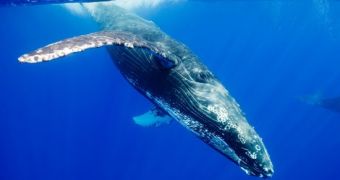Wildlife researchers who would love nothing more than being able to determine which pollutants whales are exposed to while swimming our planet's oceans need only examine the marine mammals' ear wax.
Writing in the journal Proceedings of the National Academy of Sciences, researchers argue that the wax found inside a whale's ear can serve as an indicator of the various compounds the animal has been exposed over the years.
What's more, it also hints at the stressful times the whale has experienced, Nature reports.
Environmental scientist Sascha Usenko and his fellow researchers reached these conclusions after thoroughly analyzing the makeup of a wax plug extracted from the ear of a male blue whale that died in Californian waters back in 2007.
The whale was about 12 years old at the time of its death, and passed away after being hit by a ship.
The scientists explain that, much like the rings of a tree, the wax inside a whale's ear is laid down in bands.
Thus, a new layer of wax takes about six months to form, and its color depends on the chemicals and the stressors the animal is exposed to during this time, the same source tells us.
By the looks of it, the male blue whale whose ear wax was analyzed as part of this research was exposed to 16 persistent organic pollutants from the time it was born until it died. Some of these pollutants were pesticides and flame retardants.
What's interesting is that the marine mammal's body absorbed most of these compounds during its first year of life.
Researchers say that, since these pollutants entered its body both while the whale was still inside the womb and while it was nursing, they must have been transferred from its mother.
Wax layers that contained a high concentration of a hormone named cortisol are believed to indicate the times when the male blue whale felt quite stressed, either because it was in competition with others of its kind or because of environmental factors.
The researchers believe that, all things considered, it is not unlikely that analyzing whale ear wax will one day become a run-off-the-mill method to assess how various human activities affect these marine mammals.
“We anticipate that this technique will fundamentally transform our ability to assess human impact on these environmental sentinels and their ecosystems,” they write in the Abstract to their paper.

 14 DAY TRIAL //
14 DAY TRIAL //